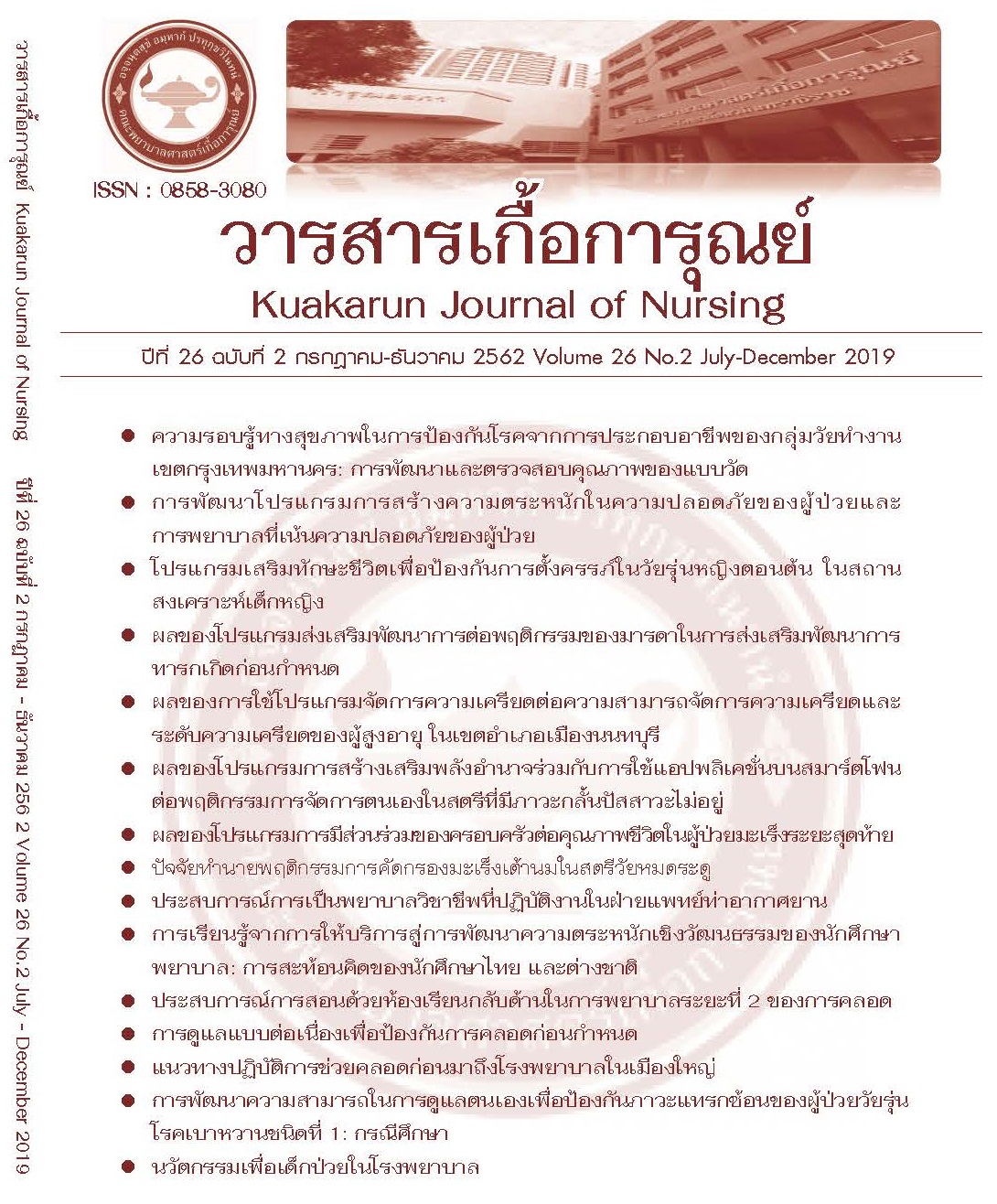The ผลของโปรแกรมการมีส่วนร่วมของครอบครัวต่อคุณภาพชีวิตในผู้ป่วยมะเร็งระยะสุดท้าย
คำสำคัญ:
โปรแกรมการมีส่วนร่วมของครอบครัว, คุณภาพชีวิต, ผู้ป่วยมะเร็งระยะสุดท้ายบทคัดย่อ
การวิจัยกึ่งทดลองนี้มีวัตถุประสงค์เพื่อศึกษาผลของโปรแกรมการมีส่วนร่วมของครอบครัวต่อคุณภาพชีวิตในผู้ป่วยมะเร็งระยะสุดท้ายโดยพัฒนาจากแนวคิดการมีส่วนร่วมของครอบครัวของ Schepp (1995) กลุ่มตัวอย่าง คือ ผู้ป่วยมะเร็งระยะสุดท้ายที่เข้ารับการรักษาที่โรงพยาบาลการแพทย์แผนไทย และการแพทย์แบบผสมผสานด้านมะเร็ง สกลนคร จำนวน 44 คน แบ่งเป็นกลุ่มควบคุมและกลุ่มทดลอง กลุ่มละ 22 คน โดยการจับคู่ผู้ดูแลให้มีลักษณะใกล้เคียงกันในเรื่อง เพศ อายุ และระดับความสามารถในการดูแลตนเองของผู้ป่วยในชีวิตประจำวัน กลุ่มควบคุมได้รับการดูแลตามปกติ ในขณะที่กลุ่มทดลองได้รับการดูแลตามปกติร่วมกับโปรแกรมการมีส่วนร่วมของครอบครัว เครื่องมือที่ใช้ในการวิจัยคือ โปรแกรมการมีส่วนร่วมของครอบครัว สื่อที่ใช้ประกอบด้วย แผนการสอน คู่มือสำหรับครอบครัวเพื่อการดูแลผู้ป่วยมะเร็งแบบประคับประคองโดยโปรแกรมและสื่อผ่านการตรวจสอบความตรงตามเนื้อหาจากผู้ทรงคุณวุฒิจำนวน 5 ท่าน เครื่องมือที่ใช้เก็บรวบรวมข้อมูลได้แก่ แบบประเมินส่วนบุคคล แบบประเมินคุณภาพชีวิตผู้ป่วยมะเร็งแบบประเมินการสนับสนุนจากครอบครัวและแบบสัมภาษณ์การมีส่วนร่วม ตรวจสอบความเที่ยงของเครื่องมือชุดที่ 2-3 ได้ค่าสัมประสิทธิ์แอลฟาของครอนบาคเท่ากับ 0.90 และ 0.96 ตามลำดับสถิติที่ใช้วิเคราะห์ข้อมูลได้แก่ ค่าเฉลี่ย ส่วนเบี่ยงเบนมาตรฐานและสถิติทดสอบค่าที
ผลการวิจัยพบว่า (1) คุณภาพชีวิตของผู้ป่วยมะเร็งระยะสุดท้ายหลังได้รับโปรแกรมการมีส่วนร่วมของครอบครัวสูงกว่าก่อนได้รับโปรแกรมอย่างมีนัยสำคัญทางสถิติที่ระดับ .05 (x̄ ก่อน=70.91; x̄ หลัง= 77.64; t=2.23, P< .05)
(2) คุณภาพชีวิตของผู้ป่วยมะเร็งระยะสุดท้ายของกลุ่มทดลองที่ได้รับโปรแกรมการมีส่วนร่วมของครอบครัวกับกลุ่มควบคุมที่ได้รับการพยาบาลตามปกติไม่แตกต่างกัน (x̄ ทดลอง=77.64; x̄ ควบคุม = 75.86; t= .41, P> .05)
เอกสารอ้างอิง
กาญจนา มยุระสุวรรณ. ( 2552). ผลของโปรแกรมการสนับสนุนและให้ความรู้ร่วมกับการผ่อนคลายกล้ามเนื้อแบบโปรเกรสซีพต่อความวิตกกังวลในญาติผู้ดูแลผู้ป่วยมะเร็งระยะลุกลาม. วิทยานิพนธ์ปริญญามหาบัณฑิต, สาขาวิชาพยาบาลศาสตร์ คณะพยาบาลศาสตร์ จุฬาลงกรณ์มหาวิทยาลัย.
กรมการแพทย์ กระทรวงสาธารณสุข. (2557). แนวทางการดูแลผู้ป่วยระยะสุดท้าย. [ระบบออนไลน์].แหล่งที่มา: http//www.dms.moph.go.th.[20 กรกฎาคม 2558].
ชมนาด วรรณพรศิริ อรวรรณ รัตนจำรูญและมลิวัลย์ ตระกูลทิพย์. (2557). ผลของรูปแบบการดูแลโดยมีครอบครัวเป็นศูนย์กลางต่อการดูแลครอบครัวและคุณภาพชีวิตของผู้ป่วยมะเร็งเต้านม. วารสารการพยาบาลและสุขภาพ, 8(2), 19-30.
ดรุณี ท่วมเพ็ชร, สธิศา ล่ามช้างและศรีพรรณ กันธวัง. (2554). ผลของกลุ่มสนับสนุนต่อการมีส่วนร่วมในการดูแลเด็กของบิดามารดาเด็กที่เข้ารับการรักษาในหอผู้ป่วยหนักกุมารเวชกรรม. พยาบาลสาร, 38( 3) , 61-72.
ทัศนีย์ ทองประทีป. (2553). พยาบาล: เพื่อนร่วมทุกข์ผู้ป่วยระยะสุดท้าย. พิมพ์ครั้งที่3. กรุงเทพฯ:บริษัท วี. พริ้นท์ (1991)
นงลักษณ์ สรรสมและสุรีพร ธนศิลป์. (2553). ปัจจัยคัดสรรที่มีความสัมพันธ์กับคุณภาพชีวิตของผู้ป่วยมะเร็งระยะสุดท้าย .วารสารพยาบาลศาสตร์ จุฬาลงกรณ์มหาวิทยาลัย ฉบับพิเศษ: 42-53.
เพ็ญศรี มรกต, กิตติกร นิลมานัติและเยาวลักษณ์ มัชฌิม. (2556). การปรับตัวของญาติผู้ดูแลผู้ป่วยระยะสุดท้ายที่เจ็บป่วยด้วยโรคเรื้อรัง. บทความวิจัยเสนอในที่ประชุมหาดใหญ่วิชาการครั้งที่4, (718) , 90-97.
มัณฑิกา ประชากิจและพิมภา สุตรา. (2555). ผลของโปรแกรมการพยาบาลครอบครัวต่อคุณภาพ ชีวิตของผู้ป่วยโรคมะเร็งลำไส้ที่ได้รับเคมีบำบัดและผู้ดูแลหลักในครอบครัว. วารสารสมาคมพยาบาลฯ สาขาภาคตะวันออกเฉียงเหนือ, 30(3), 104-112.
วงจันทร์ พิเชฐเชียร. (2554). การพยาบาลที่เป็นเลิศในการดูแลผู้ป่วยโรคมะเร็ง. สงขลา: ชานเมืองการพิมพ์.
วริสรา ลุวีระ. (2556). การดูแลสุขภาพของผู้ดูแลผู้ป่วยระยะสุดท้าย. ศรีนครินทร์เวชสาร, 28 (2), 266-70.
สมจิต หนุเจริญกุล. (2544). การดูแลตนเองศาสตร์และศิลปะทางการพยาบาล. พิมพ์ครั้งที่5. กรุงเทพฯ: ห้างหุ้นส่วนจำกัด วี. เจ. พริ้นติ้ง.
สุดารัตน์ ควระพฤกษ์. (2555). ผลของโปรแกรมการให้ครอบครัวมีส่วนร่วมในการดูแลต่อ ความรู้สึก ทุกข์ทรมานของผู้ป่วยที่ได้รับการใส่ท่อช่วยหายใจ ความวิตกกังวลและความพึงพอใจของครอบครัว. วิทยานิพนธ์ปริญญามหาบัณฑิต, สาขาการพยาบาลผู้ใหญ่ คณะพยาบาลศาสตร์ มหาวิทยาลัยธรรมศาสตร์.
สุวรรณา มณีจำนง. (2552). ประสบการณ์การดูแลแบบองค์รวมของผู้ดูแลผู้ป่วยมะเร็งระยะสุดท้ายของชีวิต. วารสารพยาบาลศาสตร์ มหาวิทยาลัยนเรศวร, 3(2), 105-116.
สุวรรณา มณีจำนง. (2551). ประสบการณ์การดูแลแบบองค์รวมของผู้ดูแลผู้ป่วยมะเร็งระยะสุดท้ายของชีวิต. วิทยานิพนธ์ปริญญามหาบัณฑิต, สาขาวิชาการพยาบาลเวชปฏิบัติชุมชน คณะพยาบาลศาสตร์ มหาวิทยาลัยนเรศวร.
สุรีพร ธนศิลป์ และพีชญดา คงศักดิ์ตระกูล. (2548). ปัจจัยทำนายคุณภาพชีวิตของผู้ป่วยมะเร็งที่ได้รับเคมีบำบัด. วารสารวิจัยทางการพยาบาล, 9(4), 306-315.
สถิติโรคมะเร็งของประเทศไทย. สถาบันมะเร็งแห่งชาติ. (2536). ข้อมูลสถิติ [ระบบออนไลน์]. แหล่งที่มา : http//www.thailabonline.com [15 มกราคม 2557].
สาธารณสุข, กระทรวง. สำนักนโยบายและยุทธศาสตร์. (2554). ข้อมูลสถิติ [ระบบออนไลน์].แหล่งที่มา : http//bps. ops. moph. go. th [15 มกราคม 2557].
สมัชชาสุขภาพ. (2556). ร่างมติสมัชชาสุขภาพเฉพาะประเด็นระเบียบวาระยุทธศาสตร์ระดับชาติว่าด้วยการสร้างเสริมสุขภาวะในระยะท้ายของชีวิต[ระบบออนไลน์].แหล่งที่มา : http//www.samatcha.org. [3 กุมภาพันธ์ 2557].
อุบล จ๋วงพานิช. (2544). บทบาทของพยาบาลในการดูแลผู้ป่วยมะเร็งระยะสุดท้าย. วารสารการศึกษาพยาบาล, 2(3), 72-77.
อรวรรณ พรคณาปราชญ์. (2555). ผลของโปรแกรมการมีส่วนร่วมของครอบครัวต่อความวิตกกังวลของผู้ป่วยมะเร็งเต้านมที่ได้รับเคมีบำบัด. วิทยานิพนธ์ปริญญามหาบัณฑิต,สาขาวิชาการพยาบาลผู้ใหญ่ คณะพยาบาลศาสตร์จุฬาลงกรณ์มหาวิทยาลัย.
Bloom JR, Petersen DM, Kang SH. (2007). Multi-dimensional quality of life among long-term(5+year) adult cancer survivors. Psycho-Oncology, 16, 691-706
Cella, D. F. (1994). Quality of life: Concepts and definition. Journal of Pain and Symptom Management, 9(3), 186-192.
Engelberg, R. A., Downey, L., Wenrich, M. D., Carline, J. D., Silvestri, G. A., Dotolo, D., . . . Curtis, J. R. (2010). Measuring the Quality of End-of-Life Care. Journal of Pain and Symptom Management, 39(6), 951-971.
Ferrell, B. R., Hassey Dow, K., & Grant, M. (1995). Measurement of the quality of life in cancer survivors. Quality of Life Research, 4(6), 523-531.
Meghani, S. H. (2004). A concept analysis of palliative care in the United States. Journal of Advanced Nursing, 46(2), 152-161.
Northouse, L. L., Walker, J., Schafenacker, A., Mood, D., Mellon, S., Galvin, E., . . . Freeman-Gibb, L. (2002). A family-based program of care for women with recurrent breast cancer and their family members. Oncology Nursing Forum, 29(10), 1411-1419.
Orem,D. (2001). Nursing Concepts of Practice (6th ed. ).St. Louis: Mosby, Inc.
Park, S. M., Kim, Y. J., Kim, S., Choi, J. S., Lim, H.-y., Choi, Y. S., . . . Yun, Y. H. (2010). Impact of caregivers' unmet needs for supportive care on quality of terminal cancer care delivered and caregiver's workforce performance. Supportive Care in Cancer, 18(6), 699-706.
Price, M. A., Bell, M. L., Sommeijer, D. W., Friedlander, M., Stockler, M. R., deFazio, A., . . . Butow, P. N. (2013). Physical symptoms, coping styles and quality of life in recurrent ovarian cancer: A prospective population-based study over the last year of life. Gynecologic Oncology, 130(1), 162-168.
Schepp, K. (1995). Psychometric assessment of the preferred participation scale for parent of hospitalized children. Unpublished manuscript, University of Washington, schoolOf Nursing, Seattle, WA.
Tamayo, G. J., Broxson, A., Munsell, M., & Cohen, M. Z. (2010). Caring for the caregiver. Oncology Nursing Forum, 37(1), E50-57.
World Health Organization. Global Atlas of Palliative care at the End of Life. World Health Organization; 2014.
Zhan, L. (1992). Quality of life: conceptual and measurement issues. Journal of Advanced Nursing, 17(7), 795-800.















